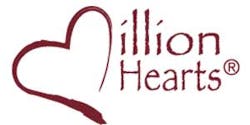Dental hygienists can make a difference in people's heart health
Americans are affected by 1.5 million heart attacks and strokes annually. The U.S. Department of Health and Human Services (HHS) released its Million Hearts® initiative in 2011, with one predominant goal – to prevent 1 million heart attacks and strokes by 2017.(1) On the three-year anniversary of the unveiling of the initiative, many are curious about what HHS has accomplished.
The Centers for Disease Control and Prevention (CDC) released a Vital Signs in 2013 showing that at least 200,000 deaths from cardiovascular disease in the U.S. could be prevented each year.(2)
Last year’s Vital Signs report found that about 80% of deaths from heart disease, stroke, and hypertension can be attributed to unhealthy lifestyle behaviors such as tobacco use, lack of physical activity, poor diet, and uncontrolled blood pressure and cholesterol. Many of these risk factors are controllable. In fact, a new study concluded that preschoolers and kindergartners tend to eat healthier lunches when the food is chosen by their school, not their parents.(3,4,5) The study, which surveyed more than 1,300 lunches at three schools in Virginia, found that parents pack things like chips, sweets, and sugary drinks, which are not allowed under the National School Lunch Program.(3)
The ABCS of heart health are also good suggestions for improving performance in cardiovascular disease prevention – Aspirin when appropriate, Blood pressure control, Cholesterol management, and Smoking cessation.(9)
Mortality from stroke has decreased significantly during the past 50 years, and better blood pressure control is thought to be the most important factor in this decline. Although carotid artery stenosis (CAS) is a risk factor for stroke, it is the cause in only a small percentage. The USPSTF has updated its 2007 recommendation statement on screening asymptomatic adults for carotid artery stenosis.(10,11)
Children can also have strokes, although it is not common. A visit to the pediatrician for minor infection during the previous three days was associated with a 12-fold increased risk for arterial ischemic stroke. Most were upper respiratory infections. The total number of infections in the previous two years did not appear to be a risk factor for stroke. Researchers propose that transient activation of blood-clotting pathways might be the mechanism by which minor infections cause a temporary increase in stroke risk. They further suggest that cold medicines with ingredients that cause vasospasm, or coughing leading to vascular injury, could be other possible mechanisms.(12)
Also, it is advantageous for health-care professionals to support educational programs, tobacco prevention incentives, wellness programs, recognition programs, and efforts to reduce sodium and eliminate trans fats. Increasing awareness of the specific actions that empower people to take control of their heart health, and helping assemble area partners to enhance the effectiveness of those efforts, will benefit the community.
As oral health-care professionals, we can raise awareness of the relationship of oral health and cardiovascular diseases, and we can encourage blood pressure monitoring and smoking cessation counseling in the dental office. Take action!
Maria Perno Goldie, RDH, MS, is the editorial director of RDH eVillage FOCUS.
References
1. http://millionhearts.hhs.gov/index.html.
2. http://www.cdc.gov/vitalsigns/HeartDisease-Stroke/.
3. Farris A, Misyak S, Diekman C, et al. Journal of Nutrition Education and Behavior. Volume 46, Issue 6, Pages 621–626, November-December 2014.
4. https://www.hnfe.vt.edu/about_us/forms/ISBNPA_2013_Assessing_Nutritional_Quality_Lunches.pdf.
5. http://www.fns.usda.gov/nslp/national-school-lunch-program-nslp.
6. http://www.cdc.gov/features/SmokersTips/.
7. http://www.cdc.gov/dhdsp/programs/sodium_reduction.htm.
8. http://millionhearts.hhs.gov/aboutmh/hypertension_control_champions_2013.html.
9. http://millionhearts.hhs.gov/DOCS/4_steps_forward_english.pdf.
10. LeFevre ML, et al. Screening for asymptomatic carotid artery stenosis: U.S. Preventive Services Task Force recommendation statement. Ann Intern Med 2014 Jul 8; [e-pub ahead of print].
11. Jonas DE, et al. Screening for asymptomatic carotid artery stenosis: A systematic review and meta-analysis for the U.S. Preventive Services Task Force. Ann Intern Med 2014 Jul 8; [e-pub ahead of print].
12. Hills NK, et al. Timing and number of minor infections as risk factors for childhood arterial ischemic stroke. Neurology, 2014 Sep 2; 83:890.





